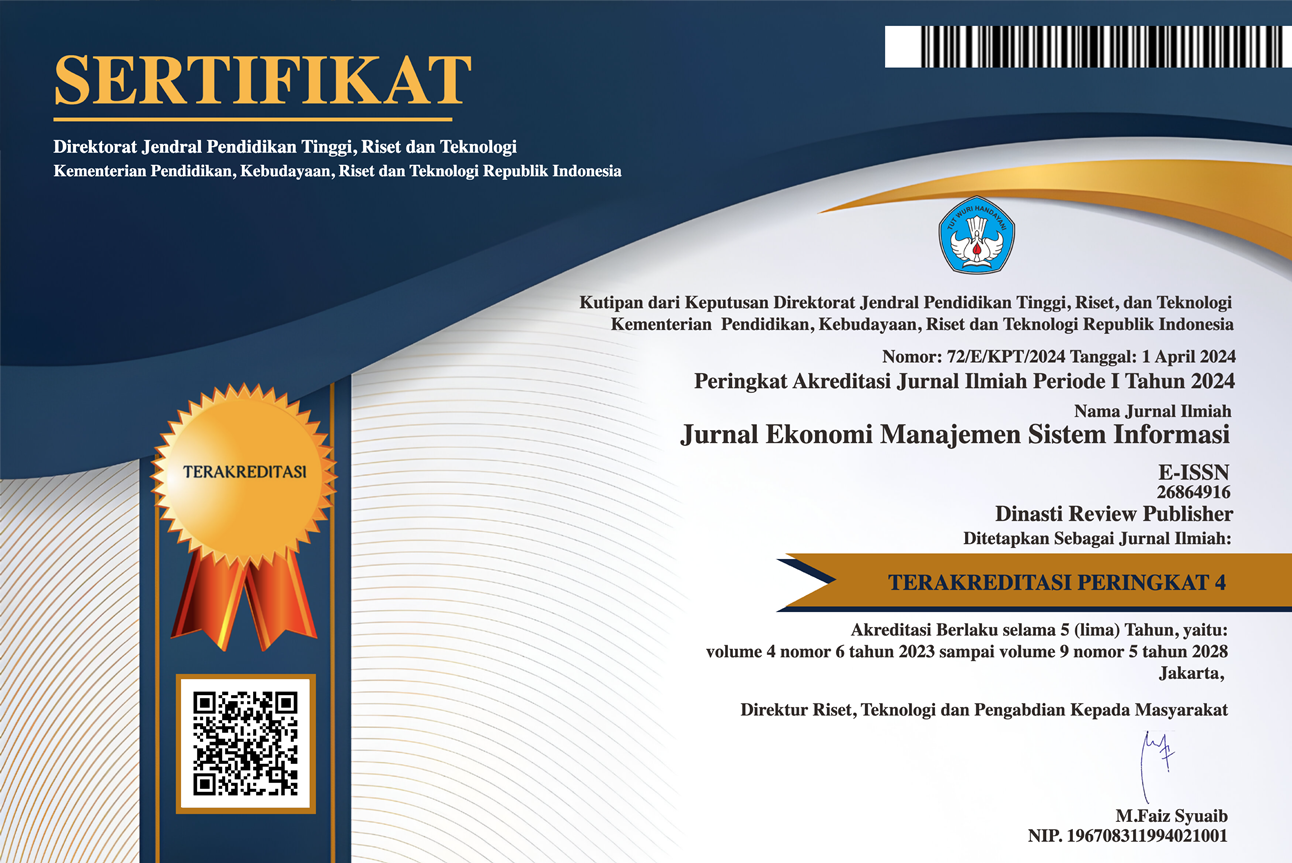Pengaruh Perceived Usefulness, Perceived Ease of Use, dan Self Efficacy Terhadap Continuance Intention to Use Electronic Medical Record Dimediasi Attitude Pada Petugas Rumah Sakit X Serang
DOI:
https://doi.org/10.38035/jemsi.v6i5.3583Keywords:
Attitude, Continuance Intention, Electronic Medical Record, Perceived Ease of Use, Perceived Usefulness, Self-EfficacyAbstract
Penerapan rekam medis elektronik tidak hanya mengurangi masalah pengelolaan terkait rekam medis kertas namun juga meningkatkan pengulangan uji laboratorium dan observasi klinis, meningkatkan keakuratan keputusan medis, serta meningkatkan keselamatan pasien. Penelitian ini bertujuan untuk mengetahui pengaruh perceived usefulness, perceived ease of use, self-efficacy terhadap continuance intention to use electronic medical record melalui dimediasi attitude pada petugas rumah sakit X Serang. Penelitian ini menggunakan desain kuantitatif serta dilakukan secara cross sectional. Jumlah sampel sebanyak 244 petugas dari berbagai profesi. Sampel dipilih dengan menggunakan metode sensus. Data penelitian diambil menggunakan media google form dengan lima pilihan jawaban. Metode analisis data menggunakan PLS-SEM. Hasil penelitian ini menemukan bahwa perceived usefulness, perceived ease of use, self-efficacy masing-masing berpengaruh positif terhadap attitude. Perceived usefulness, perceived ease of use, self-efficacy, attitude masing-masing berpengaruh positif terhadap continuance intention to use electronic medical record. Attitude masing-masing memediasi sebagian pengaruh perceived usefulness, perceived ease of use, dan self-efficacy terhadap continuance intention. Saran untuk penelitian selanjutnya dapat diperluas dengan beberapa rumah sakit lainnya di wilayah Serang dan sekitarnya. Penelitian selanjutnya juga dapat ditambahkan faktor-faktor lain yang menyebabkan tinggi rendahnya continuance intention pasien seperti norma subjektif, kepemimpinan dan budaya.
References
Abdekhoda, M., Ahmadi, M., Gohari, M., & Noruzi, A. (2015). The effects of organizational contextual factors on physicians’ attitude toward adoption of Electronic Medical Records. Journal of Biomedical Informatics, 53, 174–179.
Ahmad, A., Rasul, T., Yousaf, A., & Zaman, U. (2020). Understanding factors influencing elderly diabetic patients’ continuance intention to use digital health wearables: extending the technology acceptance model (TAM). Journal of Open Innovation: Technology, Market, and Complexity, 6(3), 81.
Ahmed, M. H., Bogale, A. D., Tilahun, B., Kalayou, M. H., Klein, J., Mengiste, S. A., & Endehabtu, B. F. (2020). Intention to use electronic medical record and its predictors among health care providers at referral hospitals, north-West Ethiopia, 2019: using unified theory of acceptance and use technology 2 (UTAUT2) model. BMC Medical Informatics and Decision Making, 20, 1–11.
Aldosari, B., Al-Mansour, S., Aldosari, H., & Alanazi, A. (2018). Assessment of factors influencing nurses acceptance of electronic medical record in a Saudi Arabia hospital. Informatics in Medicine Unlocked, 10, 82–88.
Alsyouf, A., Lutfi, A., Alsubahi, N., Alhazmi, F. N., Al-Mugheed, K., Anshasi, R. J., Alharbi, N. I., & Albugami, M. (2023). The use of a technology acceptance model (TAM) to predict patients’ usage of a personal health record system: the role of security, privacy, and usability. International Journal of Environmental Research and Public Health, 20(2), 1347.
Amran, R., Apriyani, A., & Dewi, N. P. (2022). Peran Penting Kelengkapan Rekam Medik di Rumah Sakit. Baiturrahmah Medical Journal, 1, 69–76.
Andrews, L., Gajanayake, R., & Sahama, T. (2014). The Australian general public’s perceptions of having a personally controlled electronic health record (PCEHR). International Journal of Medical Informatics, 83(12), 889–900.
Ayanso, A., Herath, T. C., & O’Brien, N. (2015). Understanding continuance intentions of physicians with electronic medical records (EMR): An expectancy-confirmation perspective. Decision Support Systems, 77, 112–122.
Bahadori, M., Alimohammadzadeh, K., Abdolkarimi, K., & Ravangard, R. (2017). Factors affecting physicians’ attitudes towards the implementation of electronic health records using structural equation modeling modeling (SEM). Shiraz E Medical Journal, 18(11).
Bao, Z., & Shang, B. (2021). Self-efficacy and continuance intention of Web 2.0 platforms: a meta-analysis. Data Technologies and Applications, 55(4), 511–526.
Daneji, A. A., Ayub, A. F. M., & Khambari, M. N. M. (2019). The effects of perceived usefulness, confirmation and satisfaction on continuance intention in using massive open online course (MOOC). Knowledge Management & E-Learning, 11(2), 201–214.
de Veer, A. J. E., & Francke, A. L. (2010). Attitudes of nursing staff towards electronic patient records: a questionnaire survey. International Journal of Nursing Studies, 47(7), 846–854.
Franque, F. B., Oliveira, T., Tam, C., & Santini, F. de O. (2021). A meta-analysis of the quantitative studies in continuance intention to use an information system. Internet Research, 31(1), 123–158.
Gagnon, M.-P., Talla, P. K., Simonyan, D., Godin, G., Labrecque, M., Ouimet, M., & Rousseau, M. (2014). Electronic health record acceptance by physicians: testing an integrated theoretical model. Journal of Biomedical Informatics, 48, 17–27.
Gajanayake, R., Sahama, T., & Iannella, R. (2013). The role of perceived usefulness and attitude on electronic health record acceptance. 2013 IEEE 15th International Conference on E-Health Networking, Applications and Services (Healthcom 2013), 388–393.
Hadji, B., Dupuis, I., Leneveut, L., Heudes, D., Wagner, J.-F., & Degoulet, P. (2014). Determinants of continuance intention in a post-adoption satisfaction evaluation of a clinical information system. In e-Health–For Continuity of Care (pp. 990–994). IOS Press.
Hair, J. F., Babin, B. J., Black, W. C., & Anderson, R. E. (2019). Multivariate Data Analysis. Cengage. https://books.google.co.id/books?id=0R9ZswEACAAJ
Hair, J. F., Risher, J. J., Sarstedt, M., & Ringle, C. M. (2019). When to use and how to report the results of PLS-SEM. European Business Review, 31(1), 2–24.
Hair Jr, J. F., Hult, G. T. M., Ringle, C. M., Sarstedt, M., Danks, N. P., & Ray, S. (2021). Partial least squares structural equation modeling (PLS-SEM) using R: A workbook. Springer Nature.
Hamid, A. A., Razak, F. Z. A., Bakar, A. A., & Abdullah, W. S. W. (2016). The effects of perceived usefulness and perceived ease of use on continuance intention to use e-government. Procedia Economics and Finance, 35, 644–649.
Hsieh, H.-L., Lai, J.-M., Chuang, B.-K., & Tsai, C.-H. (2022). Determinants of telehealth continuance intention: A multi-perspective framework. Healthcare, 10(10), 2038.
Hsieh, P.-J. (2015). Physicians’ acceptance of electronic medical records exchange: An extension of the decomposed TPB model with institutional trust and perceived risk. International Journal of Medical Informatics, 84(1), 1–14.
Huang, W.-M., Chen, T., & Hsieh, C.-W. (2014). An Empirical Study on the Physicians’ Behavioral Intention with Electronic Medical Record Systems in Taiwan. PACIS, 160.
Hung, S.-Y., Nakayama, M., Chen, C. C., & Tsai, F.-L. (2019). Physician perceptions of electronic medical records: the impact of system service quality, and generation/experience gaps. International Journal of Healthcare Technology and Management, 17(4), 229–254.
Hung, S.-Y., Yu, W.-J., Tsai, M.-F., & Yen, D. C. (2013). What drives physicians’ intention to use electronic medical record system: the roles of perceived service level, computer self-efficacy, and perceived risk.
Iqbal, U., Ho, C.-H., Li, Y.-C. J., Nguyen, P.-A., Jian, W.-S., & Wen, H.-C. (2013). The relationship between usage intention and adoption of electronic health records at primary care clinics. Computer Methods and Programs in Biomedicine, 112(3), 731–737.
Jatimoyo, D., Rohman, F., & Djazuli, A. (2021). The effect of perceived ease of use on continuance intention through perceived usefulness and trust: A study on Klikindomaret service users in Malang City. International Journal of Research in Business and Social Science (2147-4478), 10(4), 430–437.
Kabir, M. A. (2017). Continuance intention to use electronic collection system in Nigerian federal hospitals. Universiti Utara Malaysia.
Khashan, M. A., Alasker, T. H., Ghonim, M. A., & Elsotouhy, M. M. (2024). Understanding physicians’ adoption intentions to use Electronic Health Record (EHR) systems in developing countries: an extended TRAM approach. Marketing Intelligence & Planning.
Kuo, K. M., Chen, Y. C., Talley, P. C., & Huang, C. H. (2018). Continuance compliance of privacy policy of electronic medical records: the roles of both motivation and habit. BMC Medical Informatics and Decision Making, 18, 1–12.
Lakbala, P., & Dindarloo, K. (2014). Physicians’ perception and attitude toward electronic medical record. Springerplus, 3, 1–8.
Lin, K.-M. (2011). e-Learning continuance intention: Moderating effects of user e-learning experience. Computers & Education, 56(2), 515–526.
Liu, Y., Lu, X., Zhao, G., Li, C., & Shi, J. (2022). Adoption of mobile health services using the unified theory of acceptance and use of technology model: Self-efficacy and privacy concerns. Frontiers in Psychology, 13, 944976.
Lutfi, A. (2022). Factors influencing the continuance intention to use accounting information system in Jordanian SMEs from the perspectives of UTAUT: Top management support and self-efficacy as predictor factors. Economies, 10(4), 75.
Ma, C.-C., Kuo, K.-M., & Alexander, J. W. (2015). A survey-based study of factors that motivate nurses to protect the privacy of electronic medical records. BMC Medical Informatics and Decision Making, 16, 1–11.
Ma, Q., & Liu, L. (2005). The role of Internet self-efficacy in the acceptance of web-based electronic medical records. Journal of Organizational and End User Computing (JOEUC), 17(1), 38–57.
Mijin, N., Jang, H., Choi, B., & Khongorzul, G. (2019). Attitude toward the use of electronic medical record systems: Exploring moderating effects of self-image. Information Development, 35(1), 67–79.
Nematollahi, M., Moosavi, A., Lazem, M., Aslani, N., Kafashi, M., & Garavand, A. (2017). Factors affecting in adoption and use of electronic medical record based on unified theory of acceptance and use of technology in Iran. Shiraz E-Medical Journal, 18(9).
Odom, S., & Willeumier, K. (2018). Attitudes and Perceptions of behavioral health clinicians on electronic health record adoption: overcoming obstacles to improve acceptance and utilization. Perspectives in Health Information Management, 2018, 1–19.
Pan, X. (2020). Technology acceptance, technological self-efficacy, and attitude toward technology-based self-directed learning: learning motivation as a mediator. Frontiers in Psychology, 11, 564294.
Paramesthi, P., Jati, S. P., & Suryoputro, A. (2024). The use of Electronic Medical Record (EMR) in hospitals during the COVID-19 pandemic in Indonesia: a systematic literature review. BKM Public Health and Community Medicine, e11727–e11727.
Priharto, K. (2023). Implementasi EMR dengan Pendekatan User Friendly (Arsitektur Teknologi EMR). https://www.persi.or.id/ism-persi-dan-oracle-indonesia-gelar-webinar-implementasi-emr-dengan-pendekatan-user-friendly-dikuti-400-rs/
Purnawirawan, N., De Pelsmacker, P., & Dens, N. (2012). Balance and sequence in online reviews: How perceived usefulness affects attitudes and intentions. Journal of Interactive Marketing, 26(4), 244–255.
Putri, A. K., & Sonia, D. (2021). Efektivitas Pengembalian Berkas Rekam Medis Rawat Inap Dalam Menunjang Kualitas Laporan di Rumah Sakit Bhayangkara Sartika Asih Bandung. Jurnal Inovasi Penelitian, 2(3), 909–916.
Rahman, M. S., Ko, M., Warren, J., & Carpenter, D. (2016). Healthcare Technology Self-Efficacy (HTSE) and its influence on individual attitude: An empirical study. Computers in Human Behavior, 58, 12–24.
Rawashdeh, A. M., Elayan, M. B., Alhyasat, W., & Shamout, M. D. (2021). Electronic human resources management perceived usefulness, perceived ease of use and continuance usage intention: The mediating role of user satisfaction in Jordanian hotels sector. International Journal for Quality Research, 15(2), 679.
Renny, R., Guritno, S., & Siringoringo, H. (2013). Perceived usefulness, ease of use, and attitude towards online shopping usefulness towards online airlines ticket purchase. Procedia-Social and Behavioral Sciences, 81, 212–216.
Sayyah Gilani, M., Iranmanesh, M., Nikbin, D., & Zailani, S. (2017). EMR continuance usage intention of healthcare professionals. Informatics for Health and Social Care, 42(2), 153–165.
Shiau, W.-L., Yuan, Y., Pu, X., Ray, S., & Chen, C. C. (2020). Understanding fintech continuance: perspectives from self-efficacy and ECT-IS theories. Industrial Management & Data Systems, 120(9), 1659–1689.
Shiferaw, K. B., & Mehari, E. A. (2019). Modeling predictors of acceptance and use of electronic medical record system in a resource limited setting: Using modified UTAUT model. Informatics in Medicine Unlocked, 17, 100182.
Silva, A. A., & Dewi, T. S. (2023). Hambatan Implementasi Rekam Medis Elektronik dari Perspektif Perekam Medis Dengan Metode PIECES. Jurnal Manajemen Informasi Kesehatan Indonesia, 11(2).
Steininger, K., Stiglbauer, B., Baumgartner, B., & Engleder, B. (2014). Factors explaining physicians’ acceptance of electronic health records. 2014 47th Hawaii International Conference on System Sciences, 2768–2777.
Tavakoli, N., Jahanbakhsh, M., Shahin, A., Mokhtari, H., & Rafiei, M. (2013). Electronic medical record in central polyclinic of isfahan oil industry: a case study based on technology acceptance model. Acta Informatica Medica, 21(1), 23.
Vitari, C., & Ologeanu-Taddei, R. (2018). The intention to use an electronic health record and its antecedents among three different categories of clinical staff. BMC Health Services Research, 18, 1–9.
Wang, T., Wang, W., Liang, J., Nuo, M., Wen, Q., Wei, W., Han, H., & Lei, J. (2022). Identifying major impact factors affecting the continuance intention of mHealth: a systematic review and multi-subgroup meta-analysis. NPJ Digital Medicine, 5(1), 145.
Wu, B., & Zhang, C. (2014). Empirical study on continuance intentions towards E-Learning 2.0 systems. Behaviour & Information Technology, 33(10), 1027–1038.
Xie, C., Jia, S., & He, C. (2020). An empirical study on the factors affecting elderly users’ continuance intention of shared nurses. Risk Management and Healthcare Policy, 1849–1860.
Xu, Q., Hou, X., Xiao, T., & Zhao, W. (2022). Factors affecting medical students’ continuance intention to use mobile health applications. Journal of Multidisciplinary Healthcare, 471–484.
Yan, M., Filieri, R., Raguseo, E., & Gorton, M. (2021). Mobile apps for healthy living: Factors influencing continuance intention for health apps. Technological Forecasting and Social Change, 166, 120644.
Ye?ilyurt, E., Ula?, A. H., & Akan, D. (2016). Teacher self-efficacy, academic self-efficacy, and computer self-efficacy as predictors of attitude toward applying computer-supported education. Computers in Human Behavior, 64, 591–601.
Yuli, Y. (2024). Target Implementasi Digitalisasi dan EMR Tahun 2024 Serta Kesiapan RS dan Fasilitas Kesehatan. https://www.persi.or.id/webinar-target-implementasi-digitalisasi-dan-emr-2024-serta-kesiapan-rs-dan-fasilitas-kesehatan-lainnya-dalam-implementasinya-digelar-persi-dan-telkom-indonesia/
Downloads
Published
How to Cite
Issue
Section
License
Copyright (c) 2025 Qorina Putri Srisantoso, Oscar Jayanagara

This work is licensed under a Creative Commons Attribution 4.0 International License.
Hak cipta :
Penulis yang mempublikasikan manuskripnya di jurnal ini menyetujui ketentuan berikut:
- Hak cipta pada setiap artikel adalah milik penulis.
- Penulis mengakui bahwa Jurnal Ekonomi Manajemen Sistem Informasi (JEMSI) berhak menjadi yang pertama menerbitkan dengan lisensi Creative Commons Attribution 4.0 International (Attribution 4.0 International CC BY 4.0) .
- Penulis dapat mengirimkan artikel secara terpisah, mengatur distribusi non-eksklusif manuskrip yang telah diterbitkan dalam jurnal ini ke versi lain (misalnya, dikirim ke repositori institusi penulis, publikasi ke dalam buku, dll.), dengan mengakui bahwa manuskrip telah diterbitkan pertama kali di Jurnal Ekonomi Manajemen Sistem Informasi (JEMSI).











































































